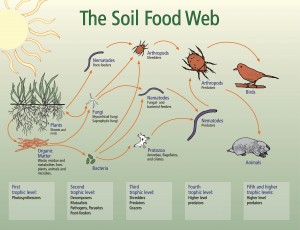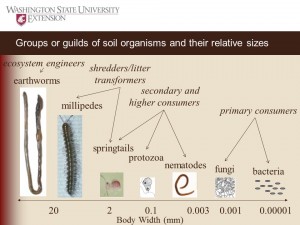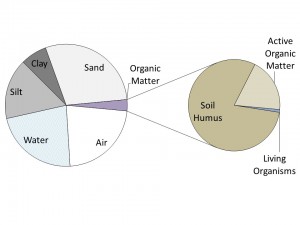Soil has been called the “fine, thin skin” of our planet. It provides numerous vital functions to sustain life on earth. Lack of soil management likely led to the collapse of several civilizations. Today, we are asking our agricultural soils to produce more food and fiber with fewer inputs and less environmental impact.
Soil quality has been defined as “the capacity of a specific kind of soil to function, within natural or managed ecosystem boundaries, to sustain plant and animal productivity, maintain or enhance water and air quality, and support human health and habitation.” Quality soil is relative to the function that one expects it to perform, but maintaining or enhancing the surrounding environment is a critical component of a quality soil. In other words, a soil that is over-fertilized or eroding and degrading the surrounding environment cannot be considered a quality soil.
To some agricultural scientists, the term “soil health” is more appropriate; producing a strong or healthy crop is the goal and soil capable of continually supporting such a crop is healthy. In addition to food production, we expect quality soil to reduce erosion, increase carbon storage, suppress soil-borne diseases, provide adequate crop nutrition, and recycle organic wastes.
Soil Biology

This diagram of the soil food web emphasizes the nutrient supplying function of soil organisms. Energy flows from plants and other carbon- and nitrogen-based soil inputs through primary and secondary decomposers and their predators.
There are other important soil functions that are not well represented by this figure. Soil ecologist David Wardle has written that these classical food web models ignore the importance of larger soil fauna that encourage decomposition and “spectacularly fail to account for these sorts of relationships, or for habitat modification by larger organisms for smaller ones” (Wardle, D. 2002). The following figure shows other groups or guilds of soil organisms and their relative sizes.

Larger soil organisms such as springtails, isopods, and millipedes are known as “shredders” or litter transformers. They consume plant debris and then pass this material as fecal pellets. Pellets have different properties than the original material. They are more conducive to colonization by microbes and serve as an external rumen for microarthropods. The pellets are then reconsumed and provide a higher level of nutrition to the organism when ingested a second or third time. This mutualism between soil microorganisms and soil microarthropods results in elevated rates of mineralization by 1) reducing the size of plant debris, 2) fecal particles are ideal medium for soil microbial activity, and 3) organic material and microbes are dispersed across and within the soil (Wolters, V., & K. Ekschmitt, 1997).
Perhaps the most cosmopolitan of the soil organisms are earthworms. Earthworms are called ecosystem engineers for their unique ability to exert pressure on the soil and change the physical properties. Their movement through the soil increase soil aggregation and can improve soil quality. Earthworms increase aggregation by 1) physically compacting smaller soil particles together, 2) creating fecal pellets – which are themselves durable aggregates, and 3) by coming to the soil surface to gather organic matter to take down into their burrows. Why do earthworms move up and down through the soil? Physiologically they are much more like aquatic organisms than terrestrial organisms and their burrows allow them to move up and down with the changing seasons and inhabit soil with the right combination of water and oxygen. In the book, The Extended Organisms: The Physiology of Animal-Built Structures, J. Scott Turner provides a fascinating account of how earthworms change soil properties to serve as their “kidney.”
Resources:
Building Soils for Better Crops, 3rd Edition 2010, Fred Magdoff and Harold van Es, Sustainable Agriculture Network, USDA Sustainable Agriculture Research and Education Program. This book contains detailed information about soil structure and how to manage nutrients, cover crops, and manure use. It provides instruction for a soil health evaluation.
Sustainable Soil Management, May 2004, Preston Sullivan, Appropriate Technology Transfer for Rural Areas (ATTRA). An excellent primer on what it takes to have a healthy soil.
Soil Biology Primer, edited by Ariene Tugel, Ann Lewandowski, and Deb Happe-vonArb. 2000. Soil and Water Conservation Society. Excellent review of the entire soil food-web. Great color plates.
Soil Organic Matter

About half of a block of soil is composed of a minerals and can be divided by size into sand, silt, and clay. The other half is about equally split between air and water. About 1 to 5 % is organic matter. Organic matter can be divided into three pools: humus, active, and living. Humus is well decomposed organic matter. Humus, also affects the nutrient holding capacity of soils. Along with clay, humus provides a place for nutrients such as calcium, magnesium, and potassium to reside until a crop needs them.
Organic matter can build and stabilize soil structure as well as reduce the potential for erosion. Organic matter improves porosity, allowing water to infiltrate and drain through the soil, and helps hold water that can be used by plants.
Humus contributes significantly to the water-holding capacity and nutrient exchange capacity of soil, but does not mineralize much nitrogen. The active organic matter is fresher material that has been added more recently to soils.
Tillage Reduction
Larger-bodied soil organisms such as earthworms and springtails are sensitive to soil disturbance. Reducing the intensity and frequency of tillage helps maintain the soil functions provided by ecosystem engineers and shredders.
Sources
Turner, J. S. 2000. The Extended Organism: The Physiology of Animal Built Structures. Harvard University Press, Cambridge, MA. 235pgs.
Wardle, D. 2002. Communities and Ecosystems: Linking the aboveground and belowground components. Princeton University Press.
Wolters, V., K. Ekschmitt. 1997. Gastropods, Isopods, Diplopods, and Chilopods: Neglected groups of the decomposer food web. In: G. Benckiser (editor). Fauna in Soil Ecosystems: Recycling Processes, Nutrient Fluxes, and Agricultural Production. Marcel Dekker, Inc, New York.